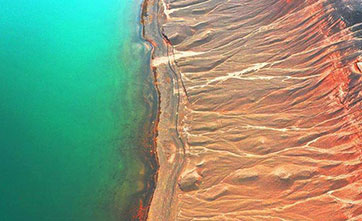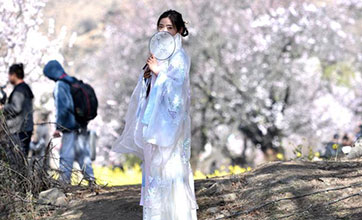Uncovering the gold mask unearthed at the Sanxingdui Ruins
CHENGDU, April 7 (Xinhua) -- An incomplete gold mask has drawn enormous interest from academics and the public after it was unearthed by archaeologists at the legendary Sanxingdui Ruins site in southwest China.
In late March, Chinese archaeologists announced they had made some major discoveries at the ruins in Sichuan Province, helping shed light on the unified yet diverse origins of Chinese civilization.
Archaeologists have found six new sacrificial pits and unearthed more than 500 items dating back about 3,000 years, according to the National Cultural Heritage Administration.
In one of the new pits, archaeologists unearthed a 286-gram gold mask. It is the biggest gold mask ever discovered at the Sanxingdui Ruins.
"We found the mask on Jan. 5 in the No. 5 pit," said one of the archaeologists involved in the excavation work. "At first, we only saw part of it, and it didn't draw much attention until more and more gold was revealed."
The archaeologists were surprised when they saw the whole item.
"It was a pleasant surprise," said Professor Li Yingfu with the school of archaeology and museology under Sichuan University. Staff from the school were part of the excavation team at the site.
But the next challenge was how to unearth the mask safely and scientifically.
Li said that it was not difficult to retrieve an item from the pit, as the condition of gold remains stable.
"But no single item was isolated after being buried for thousands of years," said Li. "If we simply took the mask out, we could destroy the connections between the buried relics and miss out on the stories behind them."
Li added that during the site's long history, some information might have been lost, so it was important to preserve and retrieve the remaining information "as much as possible" so as to understand the life of the ancient people who lived there.
After discussions, archaeologists on Feb. 2 decided to carefully remove the already deformed mask and sent it to a lab to be cleaned and repaired.
But only half of the mask was uncovered, begging the question: Where is the other half?
Li said that the other half could have been melted due to burning.
"Gold decorations have quite low melting points, and based on the signs of burning on the relics we found in the pit, we think that the other half could have been burnt," Li said. "But who knows? Maybe it is still waiting to be discovered."
The Sanxingdui Ruins are dubbed one of the greatest archeological finds of mankind in the 20th century. The site was accidentally discovered by a farmer when he was digging a ditch in the 1920s. Covering 12 square km, the ruins are located in the city of Guanghan, about 60 km from the provincial capital Chengdu. They are believed to be the remnants of the Shu Kingdom, which lasted for over 2,000 years and dates back at least 4,800 years.
In 1986, a large number of unique relics were unearthed in the No. 1 and No. 2 pits, arousing global interest. So far, more than 50,000 relics have been unearthed at Sanxingdui.
Authorities placed the Sanxingdui Ruins under state-level protection in 1988.
Photos
Related Stories
- Cultural relic restorers splice together ancient sacred tree in Sanxingdui Ruins site
- "Hot pot" artifact unearthed in Sanxingdui gives a picture of the eating habits of people from ancient times
- Over 500 relics found in prehistoric Sanxingdui Ruins in SW China
- New discoveries at Sanxingdui Ruins shed light on unified, diverse origins of Chinese civilization
- Sanxingdui discoveries shed light on ancient China
Copyright © 2021 People's Daily Online. All Rights Reserved.










